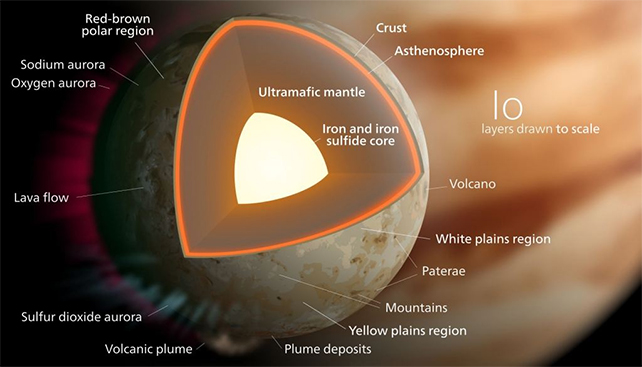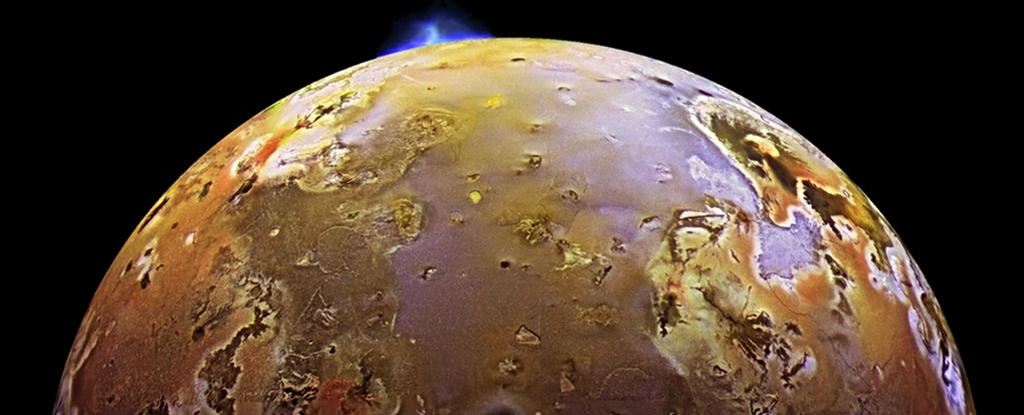The Large Binocular Telescope (LBT), located on Mount Graham in Arizona and operated by the University of Arizona, is part of the next generation of extremely large telescopes (ELTs). With two 8.4 m (~27.5 ft) primary mirrors, it has a collecting area slightly larger than that of a 30 meter (98.4 ft) telescope.
With their resolution, adaptive optics and advanced instruments, these telescopes are expected to penetrate deeper into the universe and provide stunning images of everything from distant galaxies to objects in our solar system.
An international team led by the University of Arizona recently acquired images of Jupiter’s moon Io that are the highest resolution photos ever taken by a ground-based telescope. The images revealed surface features as small as 80 km (50 miles) across, a spatial resolution previously reserved for spacecraft.
This includes NASA’s Juno mission, which captured some of the most stunning images of Io’s volcanoes. These images were made possible by the LBT’s new SHARK-VIS instrument and the telescope’s adaptive optics system.
The team was led by Al Conrad, an Associate Staff Scientist at the University of Arizona Department of Astronomy, the Stewart Observatory and the Large Binocular Telescope Observatory (LBTO). He was joined by researchers from the University of California, Berkeley, the California Institute of Technology and NASA’s Jet Propulsion Laboratory.
Their paper, “Observation of Io’s Resurfacing via Plume Deposition Using Ground-Based Adaptive Optics at Visible Wavelengths With LBT SHARK-VIS (GRL),” and the LBT images will be published in the Geophysical research letters.
SHARK-VIS is a high-contrast optical coronagraphic imaging instrument designed and built at INAF-Osservatorio Astronomico di Roma. The instrument is powered by the revised LBT extreme Adaptive Optics system, called the Single Conjugated Adaptive Optics Upgrade for LBT (SOUL). It was installed on the LBT in 2023, together with the near-infrared instrument SHARK-NIR, to take advantage of the telescope’s excellent adaptive optics system.
Key to the instrument is its high-speed, ultra-low-noise ‘fast imaging’ camera that captures slow-motion images that freeze the optical distortions caused by atmospheric interference.
Gianluca Li Causi, the data processing manager for SHARK-VIS at the Italian National Institute of Astrophysics, explained how it works in a recent news report from the University of Arizona:
“We process our data on the computer to remove any trace of the sensor’s electronic footprint. We then select the best frames and combine them using a highly efficient software package called Kraken, developed by our colleagues Douglas Hope and Stuart Jefferies from Georgia State University. With Kraken we can remove atmospheric effects, revealing Io in incredible sharpness.”
The SHARK-VIS image was so rich in detail that it allowed the researchers to identify a major event around Pele, one of Io’s largest volcanoes in the Southern Hemisphere near the equator (and named after the Hawaiian deity associated with fire and volcanoes). .
The image shows a plume deposit around Pele, overlain by eruptive deposits from Pillan Patera, a neighboring volcano. NASA’s Galileo spacecraft observed a similar series of outbursts while exploring the Jupiter system between 1995 and 2003. However, this was the first time an observatory on Earth had captured such detailed images.

“We interpret the changes as dark lava deposits and white sulfur dioxide deposits from an eruption at Pillan Patera, partially covering Pele’s red, sulfur-rich plume deposit,” said co-author Ashley Davies, chief scientist at NASA’s Jet Propulsion Laboratory. .
“Before SHARK-VIS, such resurfacing events were impossible to observe from Earth.”
Io is the innermost of Jupiter’s largest moons (also known as the Galilean moons), including Europa, Ganymede and Callisto. Ever since NASA’s Voyager 1 spacecraft flew through the Jupiter system in 1979, scientists have been fascinated by Io and its volcanic features.
Together with Europa and Ganymede, Io is locked in an orbital resonance of 1:2:4, with Europa making two orbits for every orbit that Ganymede makes, and Io making four.
Between the interactions with these moons and Jupiter’s powerful gravity, Io’s interior continually flexes, creating hot lava that bursts through the surface. Although telescopes have captured infrared images that have revealed hot spots caused by eruptions, they are not sharp enough to reveal surface details or identify the locations of the eruptions. By monitoring the eruptions on Io’s surface, scientists hope to gain insight into the tidal heating mechanism responsible for Io’s intense volcanism.
“Io therefore offers a unique opportunity to learn more about the mighty eruptions that helped shape Earth’s surfaces and the moon in their distant past,” Conrad said.
Studies like this, he added, will help researchers understand why some planets have active volcanoes and others do not. Although Venus is still believed to be volcanically active, Mars, for example, hosts the largest volcanoes in the solar system but is inactive.
These studies may also one day shed light on volcanic exoplanets, allowing astronomers to identify geological activity on distant planets (a possible indication of habitability).
SHARK-VIS instrument scientist Simone Antoniucci expects it will enable new observations of objects across the solar system with comparable sharpness, revealing a variety of features that would otherwise require spacecraft.
“SHARK-VIS’s sharp vision is particularly suited to observing the surfaces of many bodies in the solar system, not only the moons of giant planets, but also asteroids,” he said.
“We have already observed a number of them as the data is currently being analyzed, and plan to observe more.”
This article was originally published by Universe Today. Read the original article.
